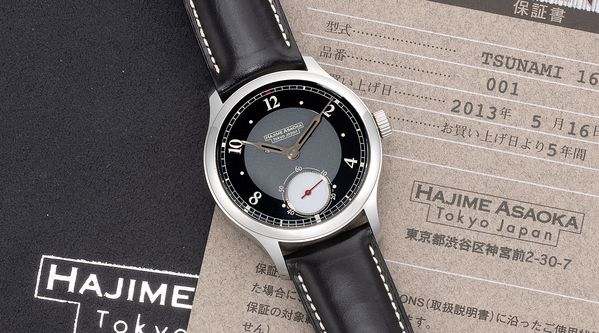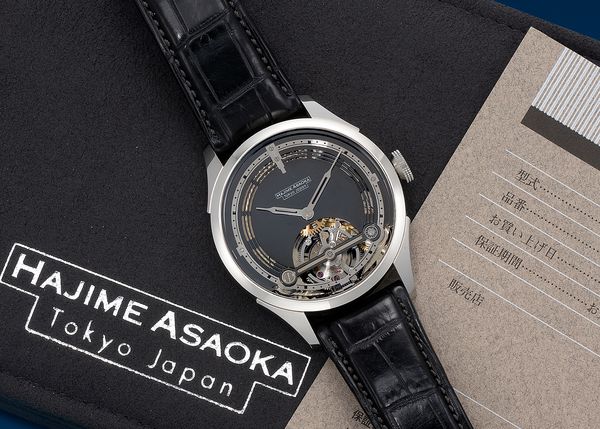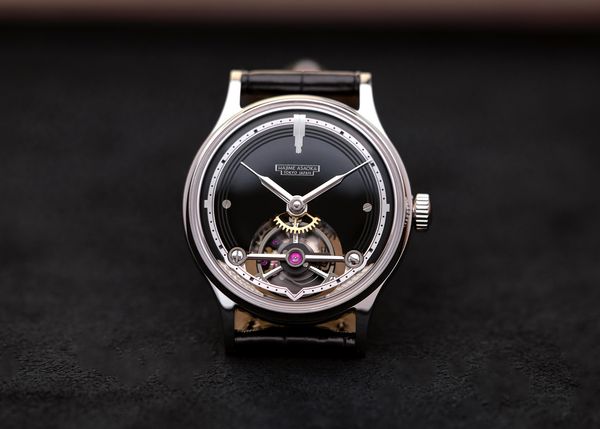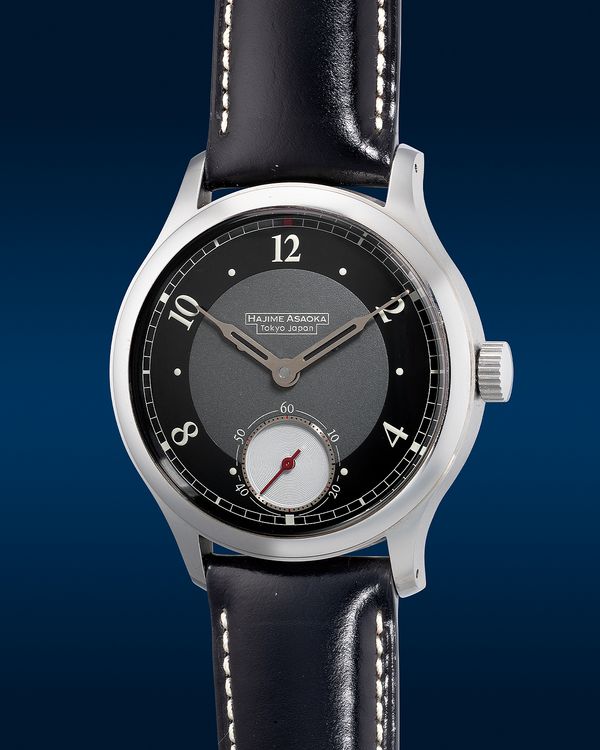The Hong Kong Watch Auction: XVI takes place on May 13 and 14, at our new Asia headquarters in the West Kowloon Cultural District. The auction includes more than 200 of the world's finest watches. We'll be highlighting a number of the most interesting lots and stories featured in the sale over the next few weeks, including the two Hajime Asaoka wristwatches featured here.
– By Logan Baker
One of the great things about this year’s Hong Kong Watch Auction: XVI catalog is the incredible number of independent watchmakers that are making their debut at Phillips. We’ve already covered Rexhep Rexhepi and his award-winning – and life-changing – Chronomètre Contemporain I, as well as the Barcelona-based upstarts at Atelier de Chronométrie and the fascinating history of the pioneering Chinese watchmaker Kiu Tai Yu.
The final independent watchmaker making its Phillips debut this week is Hajime Asaoka, a 57-year-old man who is arguably the most influential living watchmaker in Japan working under their own name. Asaoka’s name has gained a bit of notoriety in recent years after he helped develop and create a sub-brand of more affordable mechanical wristwatches under the name Kurono Tokyo. Typically priced below USD $3,000, the Kurono Tokyo watches gained a huge following just before and during the COVID-19 pandemic for their unique Japanese-influenced aesthetics and approachable price point.
The only issue? Every Kurono Tokyo watch released was only produced in limited-edition runs, frustrating some members of the international collector community.
But Kurono Tokyo is but a small facet of Hajime Asaoka’s work and will not be our focus today (although we did in fact auction off a time-only Reiwa at the Geneva Watch Auction: XV, in May 2022, for a remarkable sum of CHF 25,200). Asaoka spends a vast majority of his time focused on the watches that bear his own name – and which have production runs in the single digits rather than the hundreds or thousands.
But before we dive into the watches themselves, it’s important to understand Asaoka's background.
The Backstory
Hajime Asaoka first became interested in watches during junior high school, and his father eventually gifted him a mechanical Citizen chronograph in the late 1970s. Asaoka’s interest in watches was purely that at the time – a casual curiosity. He eventually went off to college at the Tokyo University of the Arts, where he graduated in 1990 and soon started his own business as a product designer.
Watches entered his life once again at this point, when a few clients came to him and asked for his help in designing a watch that they could then produce and sell. Asaoka’s fascination with watches continued to slowly grow, alongside personal frustration at the stop-gap nature of his work. At that point, he was only able to take part in the design process of watchmaking, but what intrigued Asaoka the most was learning every aspect of creating a watch.
So Asaoka did what any normal person would do in that situation: He purchased a copy of George Daniels’ Watchmaking in the early 2000s and slowly began to teach himself the craft. After multiple years of dedicated study and work, Asaoka returned in 2009 with his first prototype watch, the so-called Tourbillon #1, which was also the first Japanese-built tourbillon wristwatch, ever.
Following the debut of the Tourbillon #1 prototype, Asaoka was accepted as a member of the Académie Horlogère des Créateurs Indépendants (AHCI), a Swiss-based organization dedicated to preserving the art of fine handmade watchmaking and independent makers.
By the time 2011 rolled around, Asaoka was ready to begin selling the few watches he completed to interested clients.
The Watches
The Tsunami
The Tsunami is arguably Asaoka's most recognizable watch, a classic three-hand casual-dress watch with an in-house manual-wind movement and a highly wearable 37mm stainless steel case with a stepped bezel. The two-tone “Tuxedo”-style dial aesthetics are clearly inspired by Art Deco, a signature of Asaoka's style, while the movement construction is anything but standard.
The movement architecture more closely resembles a pocket watch, with a large 15mm spinning balance wheel and an extra-large mainspring barrel. It’s a watch that will appeal to collectors who love unconventional movement designs. Asaoka manufactures all the movement components for the Tsunami inside his Tokyo workshop.
Interestingly, the Tsunami example that's included in the Hong Kong Watch Auction: XVI (Estimate: HKD $40,000 - 80,000) is engraved with the serial number “001” on one of the movement bridges. I checked with Asaoka for confirmation, and he was able to provide a wealth of knowledge on the specific watch.
“The Tsunami with serial number 1 in the Phillips auction is the one I exhibited when I first attended Baselworld in 2013,” Asaoka wrote to me, via Instagram. “Compared to the current Tsunami, it is a de facto prototype with a more rustic dial finish. It was originally made for my personal use, and I actually used it for a while after Baselworld. Later, through a friend of mine, I sold it to someone who insisted on having it.”
The movement is also unique compared to later Tsunami releases. It has a 16mm balance wheel, one millimeter larger than the 15mm wheel found in the standard-production Tsunami – and there is no regulator. The reason for leaving out a regulator system was in order to improve the swing angle of the extra-large balance wheel.
The addition of something like masselottes would end up causing the balance wheel to be more susceptive to air resistance, interfering with the balance’s swing angle. The balance itself was designed by Asaoka in a way where its inertia is linked directly to the characteristics of the balance spring.
A Trio Of Tourbillons
Hajime Asaoka has been fascinated by the tourbillon throughout his entire career.
The first watch he finished – the one that earned him his AHCI membership – featured an unusual tourbillon aperture at nine o’clock on the dial side with a large, lengthy tourbillon bridge extending across almost half the dial. In the years to come, Asaoka would release a total of three different types of tourbillon wristwatches: the Project-T Tourbillon, the Tourbillon Purat, and the Tourbillon Noir, the latter of which was publicly announced in March of this year.
The Project-T Tourbillon was born from a shared interest in fine watchmaking between Asaoka, a leading Japanese tool maker named OSG, and Yuki Precision, a provider of aerospace-grade precision machines. The result is a small series of watches that combine the tradition of handcraft watchmaking with materials and tools found more commonly in aerospace engineering.
A Project-T Tourbillon from 2014 is included in the Hong Kong Watch Auction: XVI (Estimate: HKD $470,000 - 940,000). The dial is once again influenced by Art Deco design and architecture, most clearly visible through the unique styling of the hands and chapter ring. Contrasted beautifully with the glossy black-DLC dial and the 43mm stainless steel case, the frame of the tourbillon carriage is crafted entirely from titanium with ball bearings in the middle and to the right side of the bridge. Thanks to the team at Yuki Precision, the Project-T Tourbillon features some of the smallest ball bearings in the world.
The movement naturally has an unconventional architecture, but it also features downright lovely details such as the use of wolf-teeth winding gears, which are considerably more difficult to machine than standard gear teeth. Another notable feature of the watch is the use of ball bearings compared to the usual rubies.
The Tourbillon Pura, meanwhile, is a more traditional and classic take on the tourbillon format using a 40mm stainless steel case and a simplified dial and movement. The tourbillon carriage is machined from A7075 duralumin, a material typically used solely on aircrafts and rifles due to its low-specific gravity and strength, but by using this material for the tourbillon carriage, the energy supplied from the barrel can be transferred to the carriage while maintaining durability. The main function here is to ensure timekeeping accuracy by maintaining a high swing angle of the balance wheel without excessive rotation.
The final tourbillon is the baby of the group: the Tourbillon Noir is Asoaka’s smallest tourbillon wristwatch yet, measuring only 37mm in diameter. I had the chance to handle the Tourbillon Noir prototype during the AHCI Grand Exhibition in Geneva earlier this year that was attended by Asaoka himself. The new Tourbillon Noir wears lovely on the wrist and honestly looks fantastic in the metal. One of the big pieces of news here is the fact Asaoka is trying something entirely new, by using a highly modular in-house movement; every major component can simply be exchanged without hassle, if something breaks down as time goes on.
The Chronograph
Hajime Asaoka has long had an interest in classic mid-century chronographs, especially after his father gifted him that 1970s mechanical Citizen Chronograph when he was a young teenager.
Is it any surprise, then, that Asaoka would be interested in offering his own interpretation on the genre?
That’s exactly what Asaoka did in 2017 with the release of his first chronograph. His take carries forward many of the traditional technical elements found in conventional mechanical chronograph wristwatches – think column wheels, horizontal clutchs, etc. – but these critical elements, among others, are now positioned on the dial-side of the movement, where they remain visible at all hours of the day thanks to the skeletonized dial architecture and sapphire crystal.
It’s a very cool and tangible approach that allows the wearer to see the exact marching procedure of movement components for the chronograph every time it's activated.
You can learn more about and register to bid in the Hong Kong Watch Auction: XVI by visiting our online catalog.
About Phillips In Association With Bacs & Russo
The team of specialists at PHILLIPS Watches is dedicated to an uncompromised approach to quality, transparency, and client service. Phillips in Association with Bacs & Russo holds the world record for the most successful watch auction, with its Geneva Watch Auction: XIV having realized $74.5 million in 2021. Over the course of 2021 and 2022, the company sold 100% of the watches offered, a first in the industry, resulting in the highest annual total in history across all the auction houses at $227 million.
About Logan Baker
Logan has spent the past decade working in watch-focused media, reporting on every aspect of the industry. He joined Phillips in Association with Bacs & Russo at the start of 2023 as the department's Senior Editorial Manager. He splits his time between New York and Geneva.
Recommended Reading
Remembering Kiu Tai Yu, The Most Important Chinese Watchmaker Of The Modern Era






